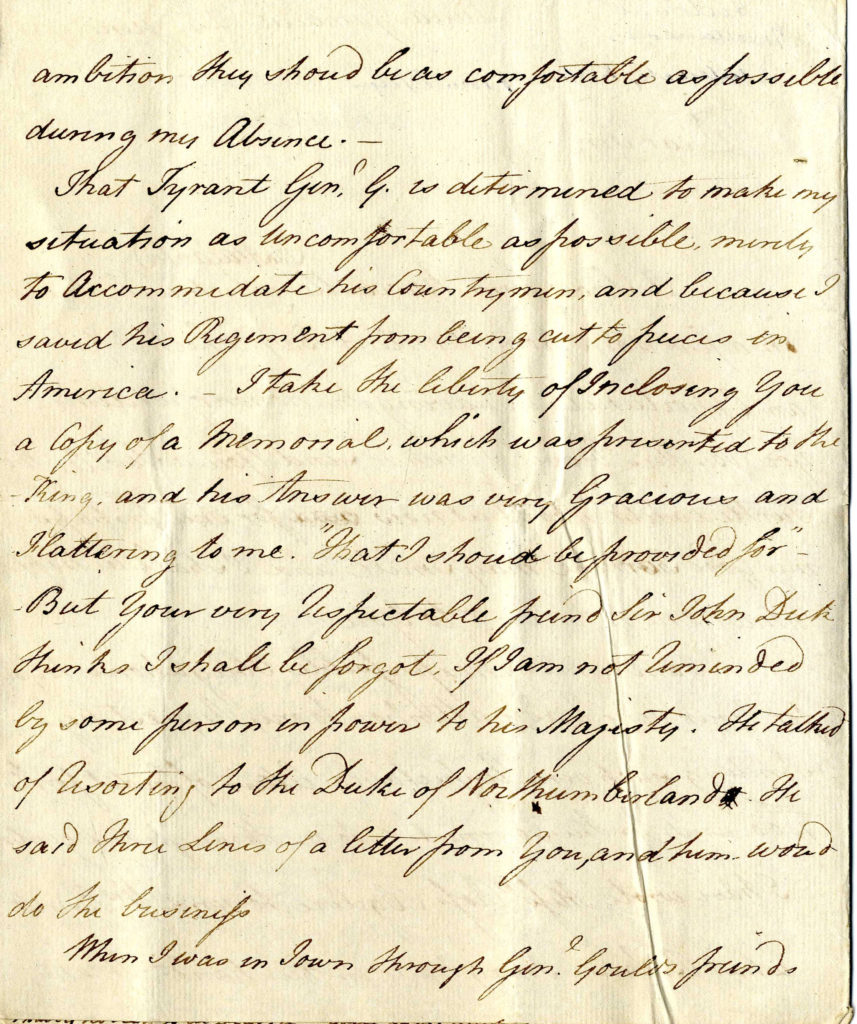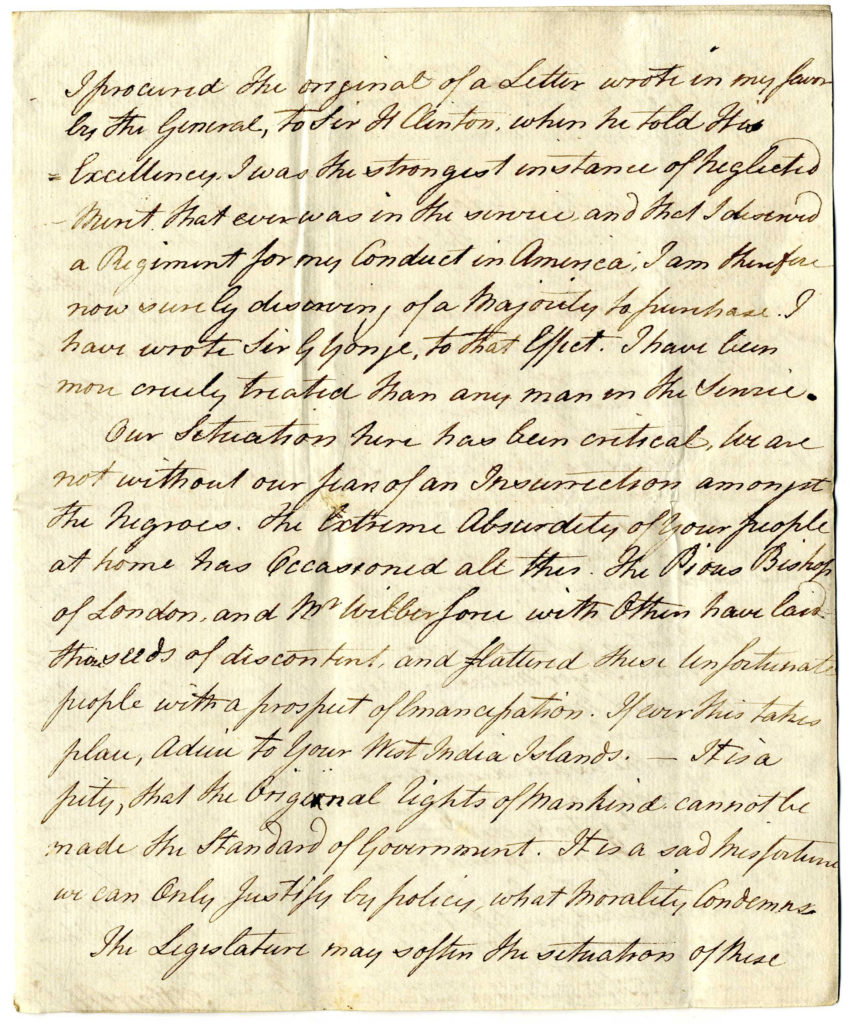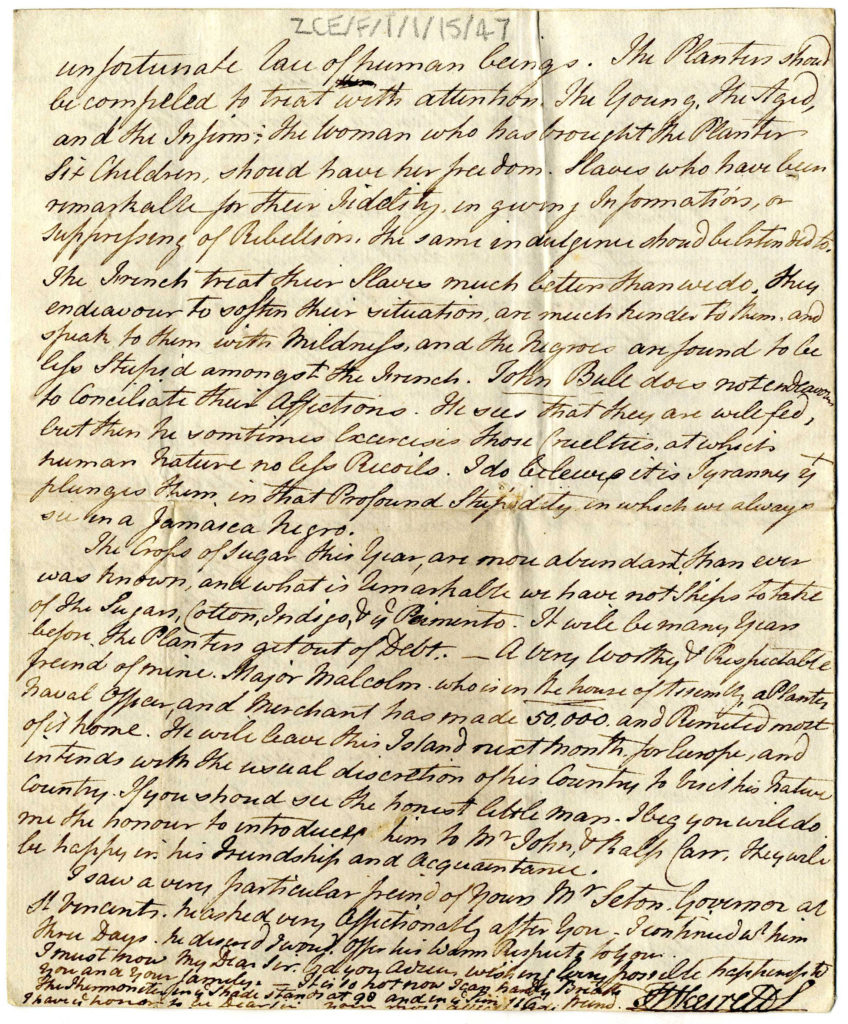Letter from John Skerrett to
Ralph Carr, 1788
Reference: ZCE F/1/1/15/47
Suggested age groups: KS2, KS3, KS4, Lifelong Learners
Subject areas: Slave Trade, Consumerism, Empire
CONTEXT
Northumberland Archives holds the Carr-Ellison family archive (ZCE). This letter is part of that collection. Ralph Ellison was an eighteenth-century merchant, based in Northumberland. He bought Hedgeley Hall, near Powburn, in 1786.
The house is still in the Carr-Ellison family. The main focus of his trade was northern Europe, but he also tried to extend his business interests into America. We have found no evidence that he had direct business interests in the trade of enslaved people.
The Skerrett family were friends of the Carr family. There are a number of letters between various members of the two families in the archives. John Nicholas Skerrett was in the army. The letters from John to Ralph repeatedly mention John’s wish for promotion and the money necessary to buy a commission. To become an officer in the army, a soldier needed to have a commission, which had to be paid for.
Skerrett refers to America several times in his letter. It seems that he fought with the British against the Americans during the American War of Independence (1775-1783). His letter gives the impression that he didn’t receive the recognition that he felt he deserved.
Pronounced loo-sea (like the girls’ name, Lucy). The British built Fort Charlotte at Lucea in 1746.
In 1661 Barbados introduced the first “Slave Code”, officially named “An Act for Better Ordering and Governing of Negroes”. The Code defined people of African origin on the island as chattels – they were the property of slaveholders, to do with as they wanted. The Code gave the holders of enslaved people the right to punish, torture and kill them. Other British colonies introduced similar Slave Codes. Jamaica adopted a version of the Barbados Act in 1664.
The structure of the plantation economies on islands like Jamaica meant that large enslaved African workforces were overseen by a very small number of white European slave holders. Revolt and resistance were a constant fear for the owners of plantations.
Resistance could take many forms; running away (it is estimated that 10% of enslaved people ran away from their holders), maintaining African traditions, refusing to work and even poisoning the food given to slave holders.
Large scale uprisings took place numerous times in Jamaica from 1655 until abolition in 1834. Tacky’s Rebellion had occurred 28 years before the writing of Major Skerrett’s letter and was therefore still within living memory. Takyi was a Ghanaian nobleman who led the 18-month uprising. (See links below for further information.)
The British took control of Jamaica from the Spanish in 1655. Some of the Africans who had been enslaved by the Spanish took this opportunity to run away into the dense Jamaican jungle and set up communities. They came to be known as Maroons. Further runaways from the British added to their numbers. During the late 1600s and early 1700s the Maroons were in conflict with the British and at war between 1728 and 1739 (The First Maroon War) and 1795-6 (The Second Maroon War). The Maroons used guerrilla tactics against the British, whose troops had greater numbers and more technologically advanced weapons.
At the time of this letter, the Society for the Effecting the Abolition of the Slave Trade had been meeting for little over a year. Opposition to the slave trade was becoming organised, particularly around the figure heads of William Wilberforce (Member of Parliament) and the Bishop of London. A parliamentary investigation into the trade (rather than slavery itself) was ordered by William Pitt, the Prime Minister, and published in April 1789.
It is interesting to note that Skerrett blames Wilberforce and the Bishop of London for raising the hopes of the enslaved people of Jamaica. This implies that the enslaved plantation workers were receiving, interpreting, and circulating news of political events in England.
A very worthy and Respectable Naval Officer, and Merchant has made 50,000
According to the Bank of England Inflation Calculator this would have been worth at least £7.7 million in 2020. This was money made from selling the products grown and processed by enslaved people.
Skerrett also mentions letters of credit worth £1000. This would have been worth about £150,000 in 2020.
Letters of credit and remittances are ways of transferring money. The development of the trade in enslaved people meant that British merchants needed to be able to send and receive money across the Atlantic. During the eighteenth-century the slaving ports of London and Liverpool became international centres for banking and insurance.
Sugar was the main export from Jamaican plantations. Indigo, a type of dye, and pimento, or all spice, were also grown on the island by enslaved workers.
Documents from the eighteenth-century regularly use language that is unacceptable. People of African descent were often called “negroes”, as in this letter.
Snow – a type of ship
House of Assembly – the parliament of Jamaica, founded 1664.
Page 1
Historical Lucea Jamaica 24 June 1788
Miscellaneous
Interesting keep From Major Skerrett
to Ralph Carr
Dear Sir
A Snow from Newcastle (the Atalanta) which will sail
in a few days from Montego Bay which offers me
an Opportunity in having the honour of writing
you. By this vessel I wish to send you a Turtle. The
Turtle catchers are Out now. For once perhaps
my Good Fortune may smile and I shall be happy
to have one to present to you.
I am under inexpressible Obligations to you
for your very ready attention to my Request by
sending such very Respectable letters of Credit for the
1000 and for the 50 remited to me through the Agents.
I have wrote Messrs Ross and Ogilow, to send Mrs Sherrett
what Balance I may have in their hands. It is my
Page 2
ambition they should be as comfortable as possible
during my Absence. –
That Tyrant Gen G is determined to make my
situation as Uncomfortable as possible mainly
to Accommodate his Countrymen and because I
saved his Regiment from being cut to pieces in
America. I take the liberty of Inclosing you
a Copy of a Memorial which was presented to the
King and his Answer was very Gracious and
Flattering to me. “That I should be provided for”
But your very Respectable friend Sir John Dick
thinks I shall be forgot. If I am not Reminded
by some person in power to his Majesty. He talked
of Resorting to the Duke of Northumberland. He
said thru lines of a letter from you and him would
do the business.
When I was in Town through Gen Gould’s friends
Page 3
I procured the original of a Letter wrote in my favour
By the General, to Sir H Clinton, when he told His
Excellency I was the strongest instance of Neglected
Mint that ever was in the service and that I deserved
a Regiment for my Conduct in America. I am therefore
now surely deserving of a Majority to purchase. I
have wrote Sir G Yonge to that Effect. I have been
more cruely treated than any man in the Service.
Our situation here has been critical we are
not without our fear of an Insurrection amongst
the Negroes. The Extreme Absurdity of your people
at home has Occasioned all this. The Pious Bishop
of London and Mr Wilberforce with Others have laid
the seeds of discontent and flattered those Unfortunate
people with a prospect of Emancipation. If ever this takes
place, Adieu to your West India Islands. – It is a
pity, that the Original Rights of Mankind cannot be
made the Standard of Government. It is a sad misfortune
we can Only Justify by policies what Morality Condemns.
The Legislature may soften the situation of these
Page 4
unfortunate Race of human beings. The Planters should
be compeled to treat with attention. The Young, the Aged,
and the Infirm; the woman who has brought the Planter
Six Children, should have her freedom. Salves who have been
remarkable for their Fidelity in giving Information, or
suppressing of Rebellion. The same in diligence should be extended[?] to.
The French treat their Slaves much better than we do. They
endeavor to soften their situation, are much kinder to them and
speak to them with Mildness and the Negroes are found to be
less Stupid amongst the French. John Bull does not endeavor
to Conciliate their Affections. He sees that they are well fed,
but then he sometimes exercises those Cruelties at which
human Nature no less Recoils. I do believe it is Tyranny that
plunges them in that Profound Stupidity in which we always
see in a Jamaica Negro.
The crops of Sugar this Year, are more abundant than ever
was known, and what is Remarkable we have not Ships to take
of the Sugar, Cotton, Indigo and ye Pimento. It will be many Years
before the Planters get out of Debt. – A very worthy and Respectable
friend of mine. Major Malcolm who is in the house of Assembly, a Planter
Naval Officer, and Merchant has made 50,000 and Remited most
of it home. He will leave this Island next month for Europe, and
intends with the usual discretion of his Country to visit his Nature
Country. If you should see the honest little man. I beg you will do
me the honour to introduce him to Mr John & Ralph Carr, They will
be happy in his Friendship and Acquaintance.
I saw a very particular friend of Yours Mr Seton. Governor at
St Vincents. He asked very Affectionatly after You. I continued with him
Three Days. He desired I would Offer his Warm Respects to you.
I must now My Dear Sir bid you Adieu wishing Every possible happiness to
You and your family. It is so hot now I can hardly Breathe
The Thermometer in ye Shade stands at 98 and in ye sun 126
I have ye honour to be Dear Sir your most [affectionate?] friend
J Skerrett
ACTIVITIES
ACTIVITY 1
Background
The Skerrett’s were friends of the Carr family. There are a number of letters between various members of the two families in the archives. John Nicholas Skerrett was in the army. The letters from John to Ralph repeatedly mention John’s wish for promotion and the money necessary to buy a commission.
At the time of this letter, the Society for the Effecting the Abolition of the Slave Trade had been meeting for little over a year. Opposition to the slave trade was becoming organised, particularly around the figure heads of William Wilberforce (Member of Parliament) and the Bishop of London. A parliamentary investigation into the trade (rather than slavery itself) was ordered by William Pitt, the Prime Minister, and published in April 1789.
It is interesting to note that Skerrett blames Wilberforce and the Bishop of London for raising the hopes of the enslaved people of Jamaica. This implies that the enslaved plantation workers were receiving, interpreting, and circulating news of political events in England.
SEE
See: Who wrote this letter?
See: Who received this letter?
See: Who were William Wilberforce and the Bishop of London?
See: How were Wilberforce and the Bishop of London involved in the abolition movement?
See: Which groups of enslaved people did John Skerrett mention should have their freedom?
THINK
Think: What impression do you have of John Skerrett after reading the letter?
Think: What is white privilege?
Think: Is white privilege shown in this letter?
Think: Did you find the candid discussion of enslaved people surprising?
Think: What were John Skerrett’s attitudes towards enslaved people?
Think: What were John Skerrett’s attitudes towards abolitionists?
Think: Did most people in Britain share John Skerrett’s attitudes towards slavery and abolitionism at the time?
Think: What was the abolition movement?
Think: Who was involved in the abolition movement?
Think: What tactics were used to progress the abolition movement?
Think: How might enslaved people in Jamaica have been receiving and interpreting news about Wilberforce from England?
DO
Do: Read through the letter and break it down into sections where different topics are discussed.
Do: Analyse each section of the letter. What is the main theme of each section?
Do: Analyse how the tone of the letter changes. What does this say about John Skerrett’s attitudes towards each topic?
Do: Consider John Skerrett’s comments about which enslaved people should be free. What does this imply about the “duty” and expectations of an enslaved person?
Do: Research Ottobah Cugoano. What can be learned from his autobiographical account about his experiences as an enslaved person?
Do: Research Oladuah Equiano. What can be learned from his autobiographical account about his experiences as an enslaved person?
Do: Research Mary Prince. What can be learned from her autobiographical account about her experiences as an enslaved person?
Do: Discuss how the personal accounts of enslaved people contributed to the abolitionist movement.
Do: Consider the Black Lives Matter protests in 2020. Discuss whether there any parallels between the media narrative around the BLM protests and the attitudes John Skerrett shows towards abolitionists.
Resources
https://www.barnardos.org.uk/blog/white-privilege-guide-for-parents
https://docsouth.unc.edu/neh/cugoano/cugoano.html
https://quod.lib.umich.edu/e/eccodemo/K046227.0001.001/1:5?rgn=div1;view=fulltext
https://spartacus-educational.com/USAScugoano.htm
https://www.youtube.com/watch?v=zQaF4BNY9LA&ab_channel=DafyddHumphreys
ACTIVITY 2
Background
The structure of the plantation economies on islands like Jamaica meant that large enslaved African workforces were overseen by a very small number of white European slave holders. Revolt and resistance were a constant fear for the owners of plantations.
Resistance could take many forms; running away (it is estimated that 10% of enslaved people ran away from their holders), maintaining African traditions, refusing to work and even poisoning the food given to slave holders.
Large scale uprisings took place numerous times in Jamaica from 1655 until abolition in 1834. Tacky’s Rebellion had occurred 28 years before the writing of Major Skerrett’s letter and was therefore still within living memory. Takyi was a Ghanaian nobleman who led the 18-month uprising.
SEE
See: Why were revolt and resistance feared by the owners of plantations?
See: What forms could resistance take?
See: How common were uprisings in Jamaica?
See: What was Tacky’s rebellion?
THINK
Think: Why did numerous uprisings take place in Jamaica?
Think: How did these uprisings take place?
Think: What were the causes and effects of uprisings?
Think: How did Tacky’s Rebellion contribute to future uprisings?
Think: What impression does the letter give about the treatment of enslaved people?
DO
Do: Consider John’s statement about how the French treated their enslaved people. Can you find evidence that John’s statement might have been false?
Do: Research autobiographical accounts about being an enslaved person. What can you learn from these first-person accounts? Do they corroborate John’s statement?
Do: Look at the images of Caribbean plantations on the Runaways website. What impression does this give you of the plantations?
Do: Research the Haitian Revolution (1791-1804). Who was involved in this revolution?
Do: Research the Haitian Revolution (1791-1804). What was the cause of the revolution and how was it connected to the French Revolution?
Do: Research Toussaint Louverture. What was his role in the Haitian Revolution?
Do: Discuss the impact of the Haitian Revolution and the changes that occurred as a result of it.
Resources
https://runaways.gla.ac.uk/minecraft/index.php/slaves-work-on-sugar-plantations/
https://www.bbc.co.uk/bitesize/topics/z2qj6sg/articles/z6cptrd
http://slavenorth.com/columns/frenchslavery.htm
https://docsouth.unc.edu/neh/prince/prince.html
https://www.history.com/this-day-in-history/haitian-independence-proclaimed
https://history.state.gov/milestones/1784-1800/haitian-rev
https://www.blackpast.org/global-african-history/haitian-revolution-1791-1804/
OTHER ONLINE RESOURCES
Revolt and Rebellion
The National Archives website, pdf of learning resources: https://www.nationalarchives.gov.uk/documents/education/resistance-and-rebellion.pdf
The National Archives website, pdf of learning resource for Bussa’s Rebellion: https://www.nationalarchives.gov.uk/documents/education/bussa.pdf
BBC Bitesize website, page about “Slave revolts” including a list of West Indian revolts and a short video about Jamaican Maroons: https://www.bbc.co.uk/bitesize/guides/z732pv4/revision/5
Abolition Project website, page about resistance (includes links to pages with case studies): http://abolition.e2bn.org/resistance.html
British Library learning website, page about “slave revolts” (including Toussaint Louverture): https://www.bl.uk/learning/histcitizen/campaignforabolition/sources/antislavery/slavrevolt/slaverevolt.html
History in Focus website (archived, no longer updated) from Institute of Historical Research, page by Natalie Zacek “Reading the rebels: currents of slave resistance in the eighteenth-century British West Indies”: https://archives.history.ac.uk/history-in-focus/Slavery/articles/zacek.html
Understanding Slavery website, page about resistance: http://www.understandingslavery.com/index.php-option=com_content&view=article&id=310&Itemid=222.html
Tacky’s Rebellion
Jamaicans website, page about Tacky’s Rebellion, including video (7 minutes 28 mins): https://jamaicans.com/tackys_rebellion/
Guardian newspaper website, page reviewing booking about Tacky’s Revolt: https://www.theguardian.com/books/2020/feb/29/tackys-revolt-review-britain-jamaica-slavery
Future Learn website, page about Tacky’s Rebellion: https://www.futurelearn.com/info/courses/slavery-in-the-british-caribbean/0/steps/162134
Understanding Slavery website, page about Tacky’s Rebellion: http://www.understandingslavery.com/index.php-option=com_content&view=article&id=382&Itemid=244.html
Maroons
Maroon Sovereignty Project (Harvard) website, page about the history of the Maroons: https://cyber.harvard.edu/eon/marroon/history.html
National Geographic website, page about Maroon communities in Jamaica: https://www.nationalgeographic.com/travel/article/legendary-community-that-fought-for-its-freedom-in-Jamaica
University of Miami student website, pages about resistance in the Caribbean including the Maroons: https://scholar.library.miami.edu/slaves/Maroons/individual_essays/leanna.html
Indigo
A Parcel of Ribbons website, page about Indigo production in Jamaica: http://aparcelofribbons.co.uk/tag/indigo/
Fort Charlotte
Jamaica Travel and Culture website, page about Fort Charlotte: http://www.jamaicatravelandculture.com/destinations/hanover/lucea/fort-charlotte.htm
Jamaica National Heritage Trust website, page about Fort Charlotte: http://www.jnht.com/site_fort_charlotte.php
John Skerrett
Canadian Dictionary of National Biography, page about John Skerrett: http://www.biographi.ca/en/bio/skerrett_john_5E.html
Ralph Carr
Northumberland Archives blog, page about Ralph Carr and his business: https://northumberlandarchives.com/2021/03/31/trading-with-america-business-misfortunes-in-18th-century-newcastle/
The Bank of England
Bank of England website, statement apologising for links to slave trade: https://www.bankofengland.co.uk/news/2020/june/statement-in-relation-to-the-banks-historical-links-to-the-slave-trade
Positive Money website, page about the Bank of England’s apology: https://positivemoney.org/2020/07/the-bank-of-england-and-the-slave-trade-why-apologies-are-not-enough/
Guardian Newspaper website, page about Bank of England apology: https://www.theguardian.com/business/2020/jun/18/bank-of-england-apologises-for-role-of-former-directors-in-slave-trade
Bank of England website, page with historical inflation calculator: https://www.bankofengland.co.uk/monetary-policy/inflation/inflation-calculator





